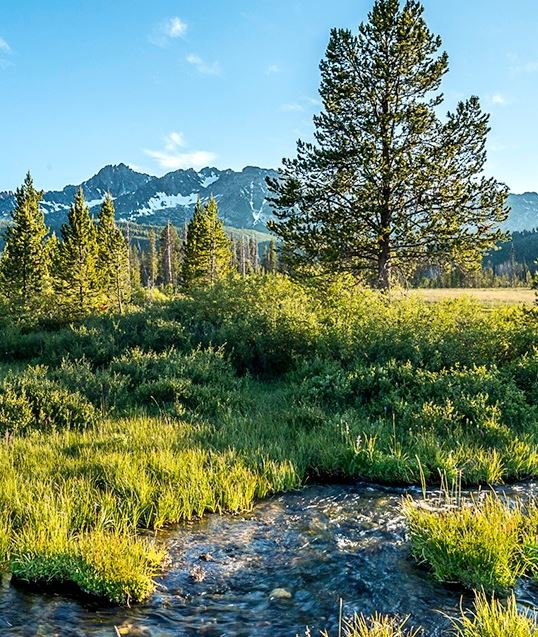Soil and Water Conservation Districts Play a Vital Role
Engaging private landowners in habitat restoration
- August 16, 2021
- Carol Winkel

The Council’s Columbia River Basin Fish and Wildlife Program, a coordinated effort to preserve the Northwest’s prized natural resources, is based on preserving and promoting healthy habitat. The program’s goals are achieved through the work of many entities, from state and tribal fish and wildlife agencies to environmental organizations. Another indispensable partner are the Soil and Water Conservation Districts throughout the basin that play a critical role in gaining the support of private landowners to implement habitat projects on their properties.
At the Council’s August fish and wildlife committee meeting, representatives from districts in Idaho, Oregon, and Washington briefed members on some of the key accomplishments from their work.
Idaho
Presenters: Karma Bragg, District Manager, Custer Soil and Water Conservation District; Bob Minton, Lemhi Soil and Water Conservation District; Ken Stinson, District Manager, Latah Soil and Water Conservation District; Lynn Rasmussen, District Manager, Nez Perce Soil and Water Conservation District
The four Soil and Water Conservation District projects in Lemhi, Custer, Latah, and Nez Perce counties work to improve habitat for ESA-listed species to mitigate the effects from hydroelectric dams. Projects implemented by the districts involve irrigation efficiency, riparian plantings, floodplain reconnection, barrier removal, and habitat protection, to name a few. Two other conservation districts, Idaho and Lewis counties also implement projects on private lands, but don’t have access to mitigation funding.
Most of the spawning areas for Chinook salmon in the Upper Salmon Basin are on private land, so the ability to forge strong working relationships with landowners has been essential to their success. Work in the Clearwater Basin is focused primarily on wild steelhead in the Potlatch River and Lapwai Creek watershed.
Oregon
Presenter: Herb Winters, District Manager, Gilliam Soil and Water Conservation District
The three Soil and Water Conservation District projects in Wasco, Gilliam, and Wheeler counties implement cost-effective floodplain restoration by protecting riparian buffer areas in critical ESA-habitat in the John Day and 15 Mile Creek basins. Other districts implement a variety of projects to restore river habitat.
The Jefferson County Soil and Water Conservation District formed a partnership with the Oregon Department of Fish and Wildlife in 1998 to restore passage and protect and restore floodplain habitat for steelhead in Trout Creek, a Deschutes River tributary. They restored function to more than 13.2 miles of stream channel and floodplain habitat, removed 24 seasonal irrigation barriers, and eliminated two passage barriers, opening an additional six miles of habitat to migrating adult steelhead.
In the Grande Ronde, the Union Soil and Water Conservation District sponsored significant habitat restoration work through the Grande Ronde Model Watershed in Catherine Creek. The Wallowa Soil and Water Conservation District performed Conservation Reserve Enhancement Program enrollments and habitat enhancement work. As part of the Willamette Wildlife Mitigation Program, districts purchased property or placed conservation easements on lands for wildlife protection. Three districts own wildlife mitigation parcels: Yamhill, Polk, and Clackamas. Total acreage for the three districts is currently at 1,281; an additional 738 acres are in the process of being acquired.
Washington
Presenters: Aneesha Dieu, District Manager, Columbia Conservation District and Megan Stewart, District Coordinator for the Asotin County Conservation District
The work conducted by the Columbia Conservation District and others in the Tucannon River watershed supports the only remaining population of spring Chinook in the lower Snake River, as well as Snake River fall Chinook, Snake River summer steelhead, and bull trout. Restoration actions to restore a healthy floodplain and naturally functioning river channel include creating pools, planting trees and shrubs, and building fencing.
The Asotin County Conservation District works with partners to protect and maintain natural processes, remove barriers, and reconnect habitats. The district builds on prior improvements, with a goal to expand efforts that improve spawning and rearing conditions for ESA-listed salmon, steelhead, bull trout, and Pacific lamprey. They have also provided cost-share funding to their efforts of over $7 million.
Noted Fish and Wildlife Committee Chair Jeff Allen, “These local districts bring the win-win by providing a level of understanding and trust between private landowners and our fish and wildlife partners—they’re a vital conduit to key allies that help us implement the program’s goals.”



